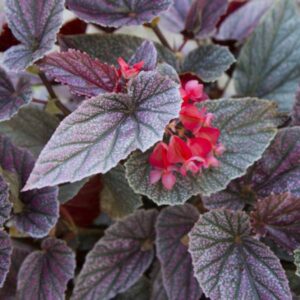Angel-wing Begonia, also known as dragon wing is a hybrid begonia plant that native to tropical regions. South America is the origin of this plant. It is the result of a cross between Begonia Aconitifolia and begonia Coccinea that was made by California breeder in 1926. It has large, ‘’angel wing’’ shaped, dark green leaves, often with metallic silver specks, and deep red underside leaf. Along with this, it produces hanging clusters of delicate flowers in red, white, orange, or pink color.

How to grow Angel-wing Begonia
- Angel wing begonia is a year-round houseplant. They are beautiful, easy-care flowering plant that brightens your home all year. Since begonias originated in the tropics, they require high humidity and proper circulation of the air around the plant.
- Along with this, they need a large amount of water and light. Light encourages the color of the flower, leaves, and results in brilliant color.
- This plant does well when the temperature is 65 degrees to 75 degrees Fahrenheit (13 degrees Celsius to 24 degrees Celsius).
- It grows well under shade cloth, lattice, or in early morning/late-afternoon sun.
- To grow the begonia plant, first, you need well-drained soil that is high in humidity.
- If you want it outdoors, then choose a location where it receives full morning sun and filtered light once the afternoon sun becomes intense.
- Feed the plant with a balanced fertilizer at the beginning. Use fertilizer with a high phosphorous product for established plants.
- Add water to the fertilizer and apply twice to the plant as recommended for an indoor plant.
- Prune out the older canes of the matured plants to encourage new shoots to grow and flower.
You can easily propagate the plant from stalk cuttings.
- You need to cut a two-leaf section of the stalk that is 4 to 6 inches (10 cm to 15 cm) from the end with the help of a sharp knife.
- Peel off the lower leaves and dip in rooting powder.
- Insert the stalk into potting soil up to 2 inches (5.1 cm).
- After inserting the stalk, moisten the soil by watering the plant.
- After a few days, gently pluck the plant and watch if the plant holds or not. If it holds, then it has grown its new roots.
- Lastly, transfer the plant into a large and regular pot for further growth of the plant.
How to care
- Provide adequate light to the plant as insufficient light causes the plant to become leggy and prevents flowering. Avoid direct sun as more light might curl the leaves and even turn brown.
- Likewise, watering should be proper and regular but do not overwater the plant. Overwater might turn the leaves into yellow and fall off.
- Likewise, you should be very careful while maintaining drip holes and proper drainage in your pot. You need to make drip holes at the bottom of the pot so that the plant should never sit in water and grow well.
- Feed your plant monthly with fertilizer and liquid plant food that is high in potassium.
When the soil feels damp, feed the plant to prevent leaf burn. - These plants are prone to mealy bugs. Use a green solution or a commercial insecticidal soap to prevent the bugs. Do not use toxic chemicals as it might damage the leaves.
- Similarly, yearly pruning is necessary for the plant during the winter or during early spring as it prevents the plant from becoming leggy.
- If the plant has outgrown its existing container, then it is a good time to re-pot your plant.
- Likewise, throughout the year, pinch off the dead flowers if any.
Benefits and uses of Angel-wing begonia plant
- The flowers and fleshy leaves of the begonia plant are edible either it is raw or cooked. It has a very sweet-tart taste; however, it might be slightly bitter after taste.
Possible side effects
- The angel-wing begonia plant is poisonous due to the insoluble oxalates in the plant. Therefore, keep it away from the reach of your pets and children.

Amelia is a plant and nature lover! Ever since she was little, she loved spending time in her family’s garden and learning about how to care for each plant individually. As an adult, she has dedicated herself to sharing what she has learned and continuing to expand her knowledge on the plant kingdom.
